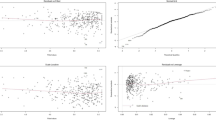Abstract
While literature maintained a strong association between emotion regulation skills and suicidal behavior, relatively less is known as to what extent this relationship goes through different dimensions of perceived social support. The purpose of the present study is to examine the possible mediator role of divergent aspects of perceived social support (family, friends, and significant other) in the relationship between difficulties in emotion regulation and suicide tendency. Conveniently selected 641 college students (430 female, 211 male) living in the different regions of Turkey constituted the sample of the present study. The findings indicated that perceived family, friends, and significant other support mediated the relationship between difficulties in emotion regulation and suicide tendency, with perceived family support being the strongest mediator. The entire model explained 51% of the variance in suicide tendency among college students. Regarding suicide tendency, males reported significantly higher scores than females. Our findings underscore that although difficulties in emotion regulation posed a significant risk factor for suicide tendency, perceived social support from family, friends, and significant other remained resilience factors that highlight the need to promote university students’ social support systems.

Similar content being viewed by others
Data availability
The datasets generated during and/or analysed during the current study are available from the corresponding author on reasonable request.
Code availability
The codes/syntax file generated for statistical analyses in SPSS and AMOS are available upon request.
References
Arbuckle, J. L. (2012). Amos (Version 21.0) [Computer Program]. IBM SPSS.
Arria, A. M., O’Grady, K. E., Caldeira, K. M., Vincent, K. B., Wilcox, H. C., & Wish, E. D. (2009). Suicide ideation among college students: A multivariate analysis. Archives of Suicide Research, 13(3), 230–246.
Baldessarini, R. J., Innamorati, M., Erbuto, D., Serafini, G., Fiorillo, A., Amore, M., & Pompili, M. (2017). Differential associations of affective temperaments and diagnosis of major affective disorders with suicidal behavior. Journal of Affective Disorders, 210, 19–21.
Bandalos, D. L., & Finney, S. J. (2001). Item parceling issues in structural equation modeling. In G. A. Marcoulides & R. E. Schumacker (Eds.), New developments and techniques in structural equation modeling (pp. 269–296). LEA.
Baumgartner, H., & Homburg, C. (1996). Applications of structural equation modeling in marketing and consumer research: A review. International Journal of Research in Marketing, 13(2), 139–161. https://doi.org/10.1016/0167-8116(95)00038-0
Brent, D. A. (2011). Preventing youth suicide: time to ask how. Journal of American Academy of Child & Adolescent Psychiatry, 50(8), 738–740. https://doi.org/10.1016/j.jaac.2010.09.017
Byrne, B. M. (2016). Structural equation modeling with Amos: Basic concepts, applications, and programming (3rd ed.). Routledge.
Centers for Disease Control and Prevention (CDC) (2018). Web-based inquiry statistics query and reporting system (WISQARS). Retrieved from www.cdc.gov/injury/wisqars
Cheung, G. W., & Rensvold, R. B. (2002). Evaluating goodness-of-fit indexes for testing measurement invariance. Structural Equation Modeling: A Multidisciplinary Journal, 9(2), 233–255. https://doi.org/10.1207/s15328007sem0902_5
Cobb, S. (1976). Social support as a moderator of life stress. Psychosomatic Medicine, 38(5), 300–314. https://doi.org/10.1097/00006842-197609000-00003
Cohen, J. (1988). Statistical power analysis for the behavioral sciences (2nd ed.). Hillsdale, NJ: Lawrence Earlbaum Associates.
Cohen, S. (2004). Social relationships and health. American Psychologist, 59(8), 676–684. https://doi.org/10.1037/0003-066x.59.8.676
Eker, D., Arkar, H., & Yaldız, H. (2001). Çok boyutlu algılanan sosyal destek ölçeği’nin gözden geçirilmiş formunun faktör yapısı, geçerlik ve güvenirliği [The factorial structure, vaildity, and reliability of the MSPSS-revised form]. Türk Psikiyatri Dergisi, 12, 17–25.
Eskin, M., Voracek, M., Stieger, S., & Altinyazar, V. (2011). A cross-cultural investigation of suicidal behavior and attitudes in Austrian and Turkish medical students. Social Psychiatry and Psychiatric Epidemiology, 46(9), 813–823. https://doi.org/10.1007/s00127-010-0254-7
Fernandes, A. C., Dutta, R., & Velupillai, S. (2018). Identifying suicide ideation and suicidal attempts in a psychiatric clinical research database using natural language processing. Scientific Reports. https://doi.org/10.1038/s41598-018-25773-2
Gençtanırım, D. (2014). Riskli davranışlar ölçeği üniversite formu: Geçerlik ve güvenirlik çalışmaları [University form of risk behaviors scale: Validity and reliability studies]. Eğitimde ve Psikolojide Ölçme ve Değerlendirme Dergisi, 5(1), 24–34.
Gross national income per capita. (n.d.). Worldbank. Retrieved April 24 2021 from https://data.worldbank.org/indicator/ny.gnp.pcap.cd?year_high_desc=true&locations=TR
Goldsmith, S. K., Pellmar, T. C., & Kleinman, A. M. (2002). Reducing Suicide: A National Imperative. Committee on Pathophysiology and Prevention of Adolescent and Adult Suicide and Board on Neuroscience and Behavioral Health
Göregenli, M. (1997). Individualist-collectivist tendencies in a Turkish sample. Journal of Cross-Cultural Psychology, 28(6), 787–794. https://doi.org/10.1177/0022022197286009
Gratz, K. L., & Roemer, L. (2004). Multidimensional assessment of emotion regulation and dysregulation: development, factor structure, and initial validation of the difficulties in emotion regulation scale. Journal of Psychopathology and Behavioral Assessment, 26(1), 41–54. https://doi.org/10.1023/B:JOBA.0000007455.08539.94
Gross, J. J. (1998). The emerging field of emotion regulation: An integrative review. Review of General Psychology, 2(3), 271. Retrieved from: http://citeseerx.ist.psu.edu/viewdoc/download?doi=10.1.1.585.6555&rep=rep1&type=pdf
Hair, J. F., Black, W. C., Babin, B. J., & Anderson, R. E. (2010). Multivariate data analysis (7th ed.). Prentice-Hall.
Hu, L. T., & Bentler, P. M. (1999). Cutoff criteria for fit indexes in covariance structure analysis: Conventional criteria versus new alternatives. Structural Equation Modeling, 6(1), 1–55. https://doi.org/10.1080/10705519909540118
IBM Corp. (2017). Released 2017. IBM SPSS Statistics for Windows, Version 25.0. IBM Corp.
Joiner, T. E., Orden, K. A., Witte, T. K., Selby, E. A., Ribiero, J. D., Lewis, R., & Rudd, M. D. (2009). Main predictions of the interpersonal-psychological theory of suicidal behavior: empirical tests in two samples of young adults. Journal of Abnormal Psychology, 118(3), 634–646. https://doi.org/10.1037/a0016500
Joiner, T. E. (2005). Why people die by suicide. Harvard University Press.
Kessler, R. C. (2005). Trends in suicide ideation, plans, gestures, and attempts in the united states, 1990–1992 to 2001–2003. The Journal of American Medical Association, 293(20), 2487–2495. https://doi.org/10.1001/jama.293.20.2487
Kessler, R. C., Borges, G., & Walters, E. E. (1999). Prevalence of and risk factors for lifetime suicide attempts in the national comorbidity survey. Archives of General Psychiatry, 56(7), 617. https://doi.org/10.1001/archpsyc.56.7.617
Khalid, R. (2012). Suicide ideation and its associated risk factors among adolescent students in the Eastern Mediterranean Region. [Unpublished Master’s thesis]. Georgia State University.
Kleiman, E. M., & Liu, R. T. (2013). Social support as a protective factor in suicide: Findings from two nationally representative samples. Journal of Affective Disorders, 150(2), 540–545. https://doi.org/10.1016/j.jad.2013.01.033
Kline, R. B. (2011). Principles and practice of structural equation modeling (3rd ed.). Guildford Press.
Klonsky, D. (2009). The functions of self-injury in young adults who cut themselves: Clarifying the evidence for affect-regulation. Psychiatry Research, 166, 260–268. https://doi.org/10.1016/j.psychres.2008.02.008.
Klonsky, E. D., & May, A. M. (2013). Differentiating suicide attempters from suicide ideators: a critical frontier for suicidology research. Suicide and Life-Threatening Behavior, 44(1), 1–5. https://doi.org/10.1111/sltb.12068
Lai, C. C., & Ma, C. M. (2016). The mediating role of social support in the relationship between psychological well-being and health-risk behaviors among Chinese university students. Health Psychology Open, 3(2), 1–11. https://doi.org/10.1177/2055102916678106
Lu, L., & Gilmour, R. (2004). Culture and conceptions of happiness: individual oriented and social oriented SWB. Journal of Happiness Studies, 5(3), 269–291.
Lu, L., Xu, L., & Luan, X. (2020). Gender difference in suicidal ideation and related factors among rural elderly: a cross-sectional study in Shandong, China. Annals of General Psychiatry, 19(2). https://doi.org/10.1186/s12991-019-0256-0
Mennin, D. S., & Fresco, D. M. (2014). Emotion regulation therapy. In J. J. Gross (Ed.), Handbook of emotion regulation (2nd ed., pp. 469–490). Guilford Press.
Miller, J. G., Bersoff, D. M., & Harwood, R. L. (1990). Perceptions of social responsibilities in India and in the United States: Moral imperatives or personal decisions? Journal of Personality and Social Psychology, 58, 33–47. https://doi.org/10.1037//0022-3514.58.1.33
Nasser, F., & Takahashi, T. (2003). The effect of using item parcels on ad hoc goodness-of-fit indexes in confirmatory factor analysis: An example using Sarason’s reactions to tests. Applied Measurement in Education, 16(1), 75–97. https://doi.org/10.1207/s15324818ame16014
O’Connor, R. C., & Kirtley, O. J. (2018). The integrated motivational-volitional model of suicidal behavior. Philosophical Transitions of the Royal Society B: Biological Sciences, 373(1754). https://doi.org/10.1098/rstb.2017.0268
Ong, E., & Thompson, C. (2018). The importance of coping and emotion regulation in the occurrence of suicidal behavior. Psychological Reports, 0(0), 1–19. https://doi.org/10.1177/0033294118781855
Palmu, R., Koskinen, S., & Partonen, T. (2020). Suicidality and psychological distress in adults aged 18 to 29 years in a population-based study in Finland. Psychiatry Research, 290, 113073.
Pierce, G. R., Sarason, B. R., & Sarason, I. G. (1996). Handbook of social support and the family. Plenum Press.
Prinstein, M. J., Boergers, J., Spirito, A., Little, T. D., & Grapentine, W. L. (2000). Peer functioning, family dysfunction, and psychological symptoms in a risk factor model for adolescent inpatients’ suicidal ideation severity. Journal of Clinical Child Psychology, 29(3), 392–405.
Rajappa, K., Gallagher, M., & Miranda, R. (2011). Emotion dysregulation and vulnerability to suicidal ideation and attempts. Cognitive Therapy and Research, 36(6), 833–839. https://doi.org/10.1007/s10608-011-9419-2
Rugancı, R. N., & Gençöz, T. (2010). Psychometric properties of a Turkish version of the difficulties in emotion regulation scale. Journal of Clinical Psychology, 66(4), 442–455. https://doi.org/10.1002/jclp.20665
Schrijvers, D. L., Bollen, J., & Sabbe, B. G. C. (2012). The gender paradox in suicidal behavior and its impact on the suicidal process. Journal of Affective Disorders, 138(1–2), 19–26. https://doi.org/10.1016/j.jad.2011.03.050
Shneidman, E. S. (1993). Commentary: Suicide as psychache. The Journal of Nervous and Mental Disease, 181(3), 145–147. https://doi.org/10.1097/00005053-199303000-00001
Sinclair, L., & Leach, R. (2017). Exploring thoughts of suicide. BMJ (Clinical research ed.), 356. https://doi.org/10.1136/bmj.j1128
Solano, P., Ustulin, M., Pizzorno, E., Vichi, M., Pompili, M., Serafini, G., & Amore, M. (2016). A Google-based approach for monitoring suicide risk. Psychiatry Research, 246, 581–586. https://doi.org/10.1016/j.psychres.2016.10.030
Tabachnick, B. G., & Fidell, L. S. (2013). Using multivariate statistics (6th ed.). Pearson/Allyn & Bacon.
Tang, F., Byrne, M., & Qin, P. (2018). Psychological distress and risk for suicidal behavior among university students in contemporary China. Journal of Affective Disorders, 228, 101–108. https://doi.org/10.1016/j.jad.2017.12.005
Triandis, H. C., Marin, G., Betancourt, H., Lisansky, J., & Chang, B. (1982). Dimensions of familialism among Hispanic and mainstream Navy recruits. Unpublished report: University of Illinois.
Turkish Statistical Institute (2015). İntihar İstatistikleri 2002–2015 [Suicide Statistics 2002–2015].
van Orden, K. A., Witte, T. K., Cukrowicz, K. C., Braithwaite, S. R., Selby, E. A., & Joiner, T. E., Jr. (2010). The interpersonal theory of suicide. Psychological Review, 117(2), 575–600. https://doi.org/10.1037/a0018697
Wang, H., Naghavi, M., Allen, C., Barber, R. M., Bhutta, Z. A., Carter, A., & Coates, M. M. (2016). Global, regional, and national life expectancy, all-cause mortality, and cause-specific mortality for 249 causes of death, 1980–2015: A systematic analysis for the Global Burden of Disease Study 2015. The Lancet, 388((10053)), 1459–1544. https://doi.org/10.1016/s0140-6736(16)31012-1
Westefeld, J. S., Homaifar, B., Spotts, J., Furr, S., Range, L., & Werth, J. L. (2005). Perceptions concerning college student suicide: data from four universities. Suicide and Life-Threatening Behavior, 35(6), 640–645. https://doi.org/10.1521/suli.2005.35.6.640
World Health Organization (2021). Suicide worldwide in 2019: global health estimates. World Health Organization. License: CC BY-NC-SA 3.0 IGO.
Zhang, Y. Y., Lei, Y. T., Song, Y., Lu, R. R., Duan, J. L., & Prochaska, J. J. (2019). Gender differences in suicidal ideation and health-risk behaviors among high school students in Beijing, China. Journal of Global Health, 9(1). https://doi.org/10.7189/jogh.09.010604
Zimet, G. D., Dahlem, N. W., Zimet, S. G., & Farley, G. K. (1988). The multidimensional scale of perceived social support. Journal of Personality Assessment, 52(1), 30–41. https://doi.org/10.1207/s15327752jpa52012
Author information
Authors and Affiliations
Corresponding author
Ethics declarations
Conflict of interest/Competing interests
We have no conflict of interest to disclose.
Ethics approval
This study was approved by the Middle East Technical University Human Subject Ethics Committee (Issue: 28,620,816/622).
Consent to participate
The authors confirm that all participants were above 16 years old and the written informed consent was obtained from the individuals.
Consent for publication
The authors affirm that participants were provided informed consent regarding publishing their data.
Additional information
Publisher’s note
Springer Nature remains neutral with regard to jurisdictional claims in published maps and institutional affiliations.
The current study is part of the first author’s MSc. thesis submitted to the Department of Educational Sciences/Middle East Technical University in August 2019 under the supervision of the co-author.
Rights and permissions
About this article
Cite this article
Demir, B., Sümer, Z.H. The mediator role of perceived social support in the relationship between difficulties in emotion regulation and suicide tendency. Curr Psychol 42, 22496–22505 (2023). https://doi.org/10.1007/s12144-022-03347-w
Accepted:
Published:
Issue Date:
DOI: https://doi.org/10.1007/s12144-022-03347-w




